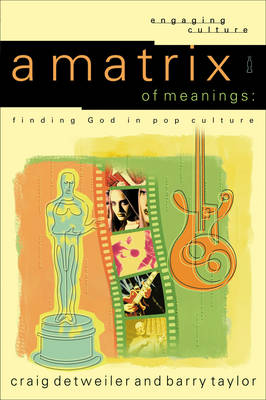Engaging Culture
3 total works
From the glittering tinsel of Hollywood to the advertising slogan you can't get out of your head, we are surrounded by popular culture. In A Matrix of Meanings Craig Detweiler and Barry Taylor analyze aspects of popular culture and ask, What are they doing? What do they represent? and What do they say about the world in which we live? Rather than deciding whether Bono deserves our admiration, the authors examine the phenomenon of celebrity idolization. Instead of deciding whether Nike's "Just do it" campaign is morally questionable, they ask what its success reflects about our society.
A Matrix of Meanings is a hip, entertaining guide to the maze of popular culture. Plentiful photos, artwork, and humorous sidebars make for delightful reading. Readers who distrust popular culture as well as those who love it will find useful insight into developing a Christian worldview in a secular culture.
A Matrix of Meanings is a hip, entertaining guide to the maze of popular culture. Plentiful photos, artwork, and humorous sidebars make for delightful reading. Readers who distrust popular culture as well as those who love it will find useful insight into developing a Christian worldview in a secular culture.
Helping Christians Understand the Power and Meaning of TV
Since its inception, television has captured the cultural imagination. Outside of work and sleep, it is now the primary preoccupation of most Americans. Individuals consume upward of five hours of TV daily, even more when taking into account viewing done online and on mobile devices. TV is so ingrained in the fabric of everyday life that it can't help but function as one of the primary means through which we make sense of our lives and the world.
This book shows that television--as a technology, a narrative art form, a commodity, and a portal for our ritual lives--confronts viewers theologically. Whether its content is explicitly spiritual or not, TV routinely invites (and sometimes demands) theological reflection. This book articulates something of the presence and activity of God in the golden age of TV and forges an appropriate response to an ever-changing cultural form. It constructs a theology of television that allows for both celebration and critique, helping Christians more fully understand and appreciate the power and meaning of TV. A supplemental website provides additional resources, conversations, and close readings of TV programs.
Since its inception, television has captured the cultural imagination. Outside of work and sleep, it is now the primary preoccupation of most Americans. Individuals consume upward of five hours of TV daily, even more when taking into account viewing done online and on mobile devices. TV is so ingrained in the fabric of everyday life that it can't help but function as one of the primary means through which we make sense of our lives and the world.
This book shows that television--as a technology, a narrative art form, a commodity, and a portal for our ritual lives--confronts viewers theologically. Whether its content is explicitly spiritual or not, TV routinely invites (and sometimes demands) theological reflection. This book articulates something of the presence and activity of God in the golden age of TV and forges an appropriate response to an ever-changing cultural form. It constructs a theology of television that allows for both celebration and critique, helping Christians more fully understand and appreciate the power and meaning of TV. A supplemental website provides additional resources, conversations, and close readings of TV programs.
Three media experts guide the Christian moviegoer into a theological conversation with movies in this up-to-date, readable introduction to Christian theology and film. Building on the success of Robert Johnston's Reel Spirituality, the leading textbook in the field for the past 17 years, Deep Focus helps film lovers not only watch movies critically and theologically but also see beneath the surface of their moving images. The book discusses a wide variety of classic and contemporary films and is illustrated with film stills from favorite movies.


